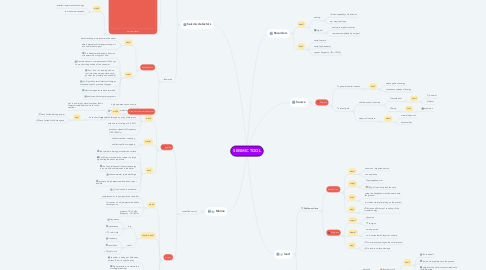
1. Marine
1.1. controlled source
1.1.1. sparker
1.1.1.1. what?
1.1.1.1.1. high powered sound source
1.1.1.1.2. convert from electrical energy
1.1.1.1.3. generated through an array of electrons
1.1.1.1.4. with a help of voltage ( 3.5-4 kV)
1.1.1.1.5. produces signal with frequency ( 100-100 kHz)
1.1.1.2. where?
1.1.1.2.1. shallow seafloor surveying
1.1.1.2.2. shallow seafloor mapping
1.1.1.3. how?
1.1.1.3.1. the sparker is being put under sea surface
1.1.1.3.2. Each firing stores electric charge in a large high-voltage bank of capacitors
1.1.1.3.3. the firing releases all the stored energy in an arc across electrodes in the water
1.1.1.3.4. the underwater spark discharge
1.1.1.3.5. produce a high-pressure plasma and vapor bubble
1.1.1.3.6. loud sound is produced
1.1.2. air gun
1.1.2.1. what?
1.1.2.1.1. compressed air is pumped into a chamber
1.1.2.1.2. consist of a high-pressure bubble that expands
1.1.2.1.3. pressure: 10-15 mPa frequency : 10-100 Hz
1.1.2.2. chamber size?
1.1.2.2.1. big
1.1.2.2.2. small
1.1.2.3. how?
1.1.2.3.1. chamber is being put below sea surface (3-6m) in specific array
1.1.2.3.2. high pressure air is stored in a discharge chamber
1.1.2.3.3. air gun is fired,the solenoid is triggered thus,releasing air
1.1.2.3.4. air escapes through portholes of sliding shuttle with pistons at each end
1.1.2.3.5. produces a primary energy pulse and an oscillating bubble
1.1.2.3.6. seismic energy generates
1.1.2.4. why?
1.1.2.4.1. to generate an optimally tuned energy output
1.1.2.4.2. cluster guns produce sound more efficiently than a single large gun
2. Seismic detectors
2.1. land
2.1.1. geophones
2.1.1.1. what?
2.1.1.1.1. measure a single component of motion (vertical) ONLY
2.1.1.1.2. common: the moving coil geophone
2.1.1.2. why?
2.1.1.2.1. controls the frequency or signal that will be recorded
2.1.1.2.2. max amplitude is at lower frequency
2.1.1.2.3. as low pass-filter
2.1.1.3. aspect?
2.1.1.3.1. natural frequency is IMPORTANT
2.1.1.3.2. output: frequency has greatest value (highest response of free oscillation)
2.1.2. seismometer
2.1.2.1. what?
2.1.2.1.1. installed in permanent housings
2.1.2.1.2. to monitor earthquake
2.2. marine
2.2.1. hydrophones
2.2.1.1. what?
2.2.1.1.1. detect a change in pressure in the water
2.2.1.1.2. detect piezoelectric elements change it into an electrical signal
2.2.1.2. uses?
2.2.1.2.1. it is been towed behind a boat in a streamer with a length of 5km
2.2.1.2.2. Pressure sensors, compasses and tail buoys :to monitor the position of the streamer
2.2.1.2.3. fins / bird : as steering device controls: streamer separation and position (horizontally and vertically)
2.2.1.2.4. it will produce small electrical charges when exposed to pressure changes.
2.2.1.2.5. electrical signals are been recorded
2.2.1.2.6. analyze with computer programs
2.2.2. ocean-bottom seismometer
2.2.2.1. what?
2.2.2.1.1. put in an airtight, metal container that is lowered overboard and sinks to the seafloor
2.2.2.1.2. have short lives
3. Source
3.1. Purpose
3.1.1. To generate seismic waves
3.1.1.1. how?
3.1.1.1.1. single pulse of energy
3.1.1.1.2. continuous sweeps of energy
3.1.2. To investigate
3.1.2.1. shallow subsoil structure
3.1.2.1.1. Geotechnical
3.1.2.1.2. Mining
3.1.2.2. deep soil structure
3.1.2.2.1. what?
4. land
4.1. Shallow surface
4.1.1. weight drop
4.1.1.1. what?
4.1.1.1.1. known as 'impacted source'
4.1.1.1.2. non-explosive
4.1.1.2. using?
4.1.1.2.1. 7kg sledgehammer
4.1.1.2.2. 75kg of load drop by 4x4x truck
4.1.1.3. how?
4.1.1.3.1. swing the sledgehammer downward onto the ground
4.1.1.3.2. to strike a metal plate lying on the ground
4.1.1.4. why?
4.1.1.4.1. increase efficiency of coupling of the transfer energy
4.1.2. Explosive
4.1.2.1. using?
4.1.2.1.1. dynamite
4.1.2.1.2. shotgun
4.1.2.2. where?
4.1.2.2.1. swampy area
4.1.2.2.2. soft, unweathered layers of surface
4.1.2.3. why?
4.1.2.3.1. to improve coupling to the solid ground
4.1.2.3.2. to reduce surface damage
4.2. Deep surface
4.2.1. Vibratory
4.2.1.1. what?
4.2.1.1.1. vibroseis
4.2.1.1.2. seismic sweeps
4.2.1.2. how?
4.2.1.2.1. a large mass is place in contact with the ground surface
4.2.1.2.2. the mass vibrates according to a specific pattern
4.2.1.2.3. set the duration of signal generation in seconds
4.2.1.2.4. the signal frequency produced and is continuously varied
4.2.1.3. why?
4.2.1.3.1. for seismic exploration
4.2.1.3.2. to propagate energy signals into the earth over an extended period of time
5. Recorders
5.1. what?
5.1.1. analog
5.1.1.1. limited capability of the device
5.1.1.2. eg: magnetic tape
5.1.2. digital
5.1.2.1. analog to digital converter
5.1.2.2. represent amplitude by a signal
5.2. how?
5.2.1. sampling rate
5.2.2. sampling frequency
5.2.3. nyquist frequency ( fN= 1/(2Δt))
